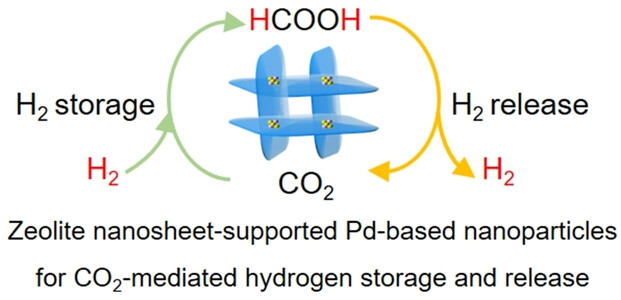Highly Dispersed Pd-CeOx Nanoparticles in Zeolite Nanosheets for Efficient CO2-Mediated Hydrogen Storage and Release
Chengxu Li1, Guangyuan He2,3, Ziqiang Qu1, Kai Zhang1, Liwen Guo1, Tianjun Zhang5, Jichao Zhang6, Qiming Sun1(孙启明)*, Donghai Mei2,3(梅东海)*, Jihong Yu4
1Innovation Center for Chemical Science, College of Chemistry,Chemical Engineering and Materials Science, Jiangsu Key Laboratory of Advanced Negative Carbon Technologies Soochow University Suzhou 215123, P. R. China
2School of Materials Science and Engineering, Tiangong University Tianjin 300387, P. R. China
3School of Environmental Science and Engineering, Tiangong University Tianjin 300387, P. R. China
4State Key Laboratory of Inorganic Synthesis and Preparative Chemistry, International Center of Future Science, College of Chemistry Jilin University Changchun 130012, P. R. China
5State Key Laboratory of New Pharmaceutical Preparations andExcipients, College of Chemistry and Materials Science Hebei University Baoding 071002, P. R. China
6Shanghai Synchrotron Radiation Facility, Shanghai Advanced Research Institute Chinese Academy of Sciences Shanghai 201204, P. R. China
Angew. Chem. Int. Ed. 2024, 63, e202409001
Abstract: Formic acid (FA) dehydrogenation and CO2 hydrogenation to FA/formate represent promising methodologies for the efficient and clean storage and release of hydrogen, forming a CO2-neutral energy cycle. Here, we report the synthesis of highly dispersed and stable bimetallic Pd-based nanoparticles, immobilized on self-pillared silicalite-1 (SP-S-1) zeolite nanosheets using an incipient wetness co-impregnation technique. Owing to the highly accessible active sites, effective mass transfer, exceptional hydrophilicity, and the synergistic effect of the bimetallic species, the optimized PdCe0.2/SP-S-1 catalyst demonstrated unparalleled catalytic performance in both FA dehydrogenation and CO2 hydrogenation to formate. Remarkably, it achieved a hydrogen generation rate of 5974 molH2 molPd−1 h−1 and a formate production rate of 536 molformate molPd−1 h−1 at 50 °C, surpassing most previously reported heterogeneous catalysts under similar conditions. Density functional theory calculations reveal that the interfacial effect between Pd and cerium oxide clusters substantially reduces the activation barriers for both reactions, thereby increasing the catalytic performance. Our research not only showcases a compelling application of zeolite nanosheet-supported bimetallic nanocatalysts in CO2-mediated hydrogen storage and release but also contributes valuable insights towards the development of safe, efficient, and sustainable hydrogen technologies.

链接://onlinelibrary.wiley.com/doi/10.1002/anie.202409001